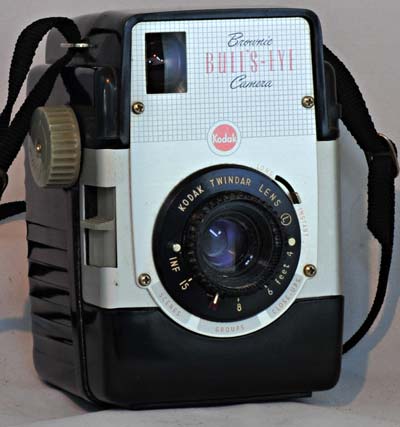Kodak Brownie Bull's-Eye
Specification

| Manufacturer | : | Kodak |
|---|---|---|
| Produced | : | 1954 |
| Classification | : | Medium Format |
| Body Type | : | Solid Body |
| Construction | : | Bakelite |
| Film Type | : | 620 |
| Film Width | : | 62mm |
| ImageSize | : | 3¼ x 2¼ in |
| No. of Images | : | 8 |
| Lens Type | : | Twindar |
| Focal Length | : | 90mm |
| Focus Type | : | variable |
| Focal Range | : | 4ft - inf. |
| Aperture Type | : | Fixed |
| Aperture | : | f/13 |
| Shutter Type | : | Rotary |
| Shutter Speed | : | B,I*(1/30sec) |
| Size (w x h x d) | : | 115 x 105 x 85 mm |
| Weight | : | 338g |
| * measured on this camera | ||
Art Deco Credentials
![]()
![]()
![]()
Noteworthy: Worth giving special attention
- Designed after the main Art Deco period
- Horizontal ribbing on the Bakelite body
- Grid pattern on camera face
- Brushed aluminium on camera face
- Curved Streamline Moderne design
Description
The Brownie Bull's-Eye is a Bakelite Box camera taking 8 6x9 exposures on 620 film. It was designed by Arthur H Crapsey and made by Kodak between 1954 & 1960.
This Bull's-Eye is black with a light-grey winding knob and focus & shutter-release. From 1957, a beige colour model with black winding knob and focus & shutter-release was produced. You could buy a kit which included a Kodalite-mount "Midget" flashgun.
The Bull's-Eye was an amateur-level box camera. The casing is made from thick bakelite which makes the camera to feel very substantial in the hand.
The Bull's-Eye has a "Twindar" two-element periscopic lens which can focus between 4ft and infinity. Markings allow for zone-focusing for scenes, groups or close-ups. There is a 'click stop' at 10 feet which will give sharp focus anywhere between 6 and 25 feet.
The Bull's-Eye's shutter locks after firing and ared zig-zag appears in the viewfinder. This zig-zag is withdrawn when the photographer turns the winder which also unlocks the shutter. This is to prevent double exposures although overlapping exposures and skipped frames are still possible.
The latch on the back rotates a quarter-turn to release the front of the camera for loading the film.
The camera also features metal strap lugs on the sides and a tripod socket. The red window on the rear does not have a cover.
How to Use
See the User Manual here:- Kodak Brownie Bull's-Eye manual
This camera takes 620 film which is still available from selected photographic outlets. Although the actual film is the same as 120 film, the spools are different. The 620 spools are slightly shorter and have a smaller diameter. Do not use 120 film in this camera because it will jam and may snap. It is possible to cut down a spool of 120 film to fit or to re-spool some 120 film onto 620 spools in a darkroom or changing bag.
This camera has an aperture of f/13 and a shutter speed is 1/30s.
As the shutter speed is only 1/30s, it is advisable to try to hold the camera against a wall or other solid object. For quick snapshots, hold it firmly against your body. You should cover the red window with some black tape when not advancing the film. Modern film is more sensitive to red light.
If you don't want to bother with an exposure meter, follow the guide shown. It is based on the 'Sunny 16' rule. Film is so forgiving and will produce acceptable results even when overexposed by 2 or 3 stops or underexposed by 1 stop.
Remember that the exposure guide in the camera user manual may not be helpful as it is based on the use of old film with a low ISO value.
The table assumes that the sun is at least 30 degrees above the horizon - that's 10am - 5pm on a summer's day in the UK.
Using ISO 100/125 film - shutter speed 1/30s
| Weather Conditions | Shadow Detail | Aperture | Exposure |
|---|---|---|---|
 Sunny SunnySnow/Sand | Dark with sharp edges | f/13 | +2 Stops Overexposed Acceptable |
 Sunny Sunny | Distinct | f/13 | +1 Stops Overexposed Acceptable |
 Slight Overcast Slight Overcast | Soft around edges | f/13 | Good |
 Overcast Overcast | Barely visible | f/13 | -1 Stop Underexposed Acceptable |
 Heavy Overcast Heavy Overcast | None | f/13 | -2 Stop Underexposed Not Acceptable |
 Open Shade Open Shade/Sunset | None | f/13 | -3 Stop Underexposed Not Acceptable |